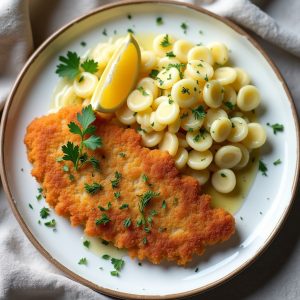
AI generated image
Chef's Tip
When pounding the veal, place it between two sheets of plastic wrap and use gentle, even strokes working from the center outward. This prevents tearing and ensures even cooking in the final dish.
Instructions
- For the spaetzle dough: In a large bowl, whisk together 2 cups flour, 1 tsp salt, and nutmeg. In another bowl, beat 4 eggs with milk. Make a well in the flour mixture, pour in egg mixture, and stir until smooth. Fold in 2 tbsp chopped dill. Let rest 10 minutes.
- Bring a large pot of salted water to a boil. Working in batches, press spaetzle dough through a colander or spaetzle maker into the boiling water. Cook until the spaetzle float to the top, about 2-3 minutes. Remove with a slotted spoon and place in ice water to stop cooking.
- Once all spaetzle are cooked and cooled, drain well and set aside.
- For the schnitzel: Set up a breading station with three shallow dishes - one with flour seasoned with salt and pepper, one with beaten eggs, and one with breadcrumbs.
- Pat veal cutlets dry with paper towels. Season with salt and pepper.
- Dredge each cutlet in flour, shaking off excess, then dip in eggs, and finally coat with breadcrumbs, pressing gently to adhere.
- Heat oil in a large skillet to 350°F. Carefully place breaded cutlets in hot oil, working in batches if necessary, and fry until golden brown, about 2-3 minutes per side.
- Transfer to a paper towel-lined plate and keep warm.
- In a large skillet, melt 3 tbsp butter over medium heat. Add drained spaetzle and sauté until lightly browned and heated through, about 3-4 minutes. Stir in remaining dill and season with salt and pepper.
- For lemon butter sauce: In a small saucepan, melt the remaining 1 tbsp butter over low heat. Remove from heat and stir in 2 tsp lemon juice and a pinch of salt.
Plating
Place a generous portion of spaetzle on each plate. Top with a schnitzel cutlet. Drizzle with lemon butter sauce and garnish with chopped parsley and a lemon wedge on the side. Serve immediately while hot and crispy.
Storage & Reheating
Schnitzel is best consumed immediately after cooking. If necessary, store leftover schnitzel and spaetzle separately in airtight containers in the refrigerator for up to 2 days. Reheat schnitzel in a 350°F oven until warmed through, and sauté spaetzle in butter to refresh. The texture will not be as crisp as when freshly made.
About This Recipe
Wiener Schnitzel represents one of the most iconic dishes in German cuisine. This adaptation of the Jacob Wirth version maintains the traditional preparation of thinly pounded veal breaded and fried to golden perfection. The herbed spaetzle adds a distinctly German element with the bright addition of fresh dill. The lemon butter sauce provides the classic acidic counterpoint that cuts through the richness of the dish.
